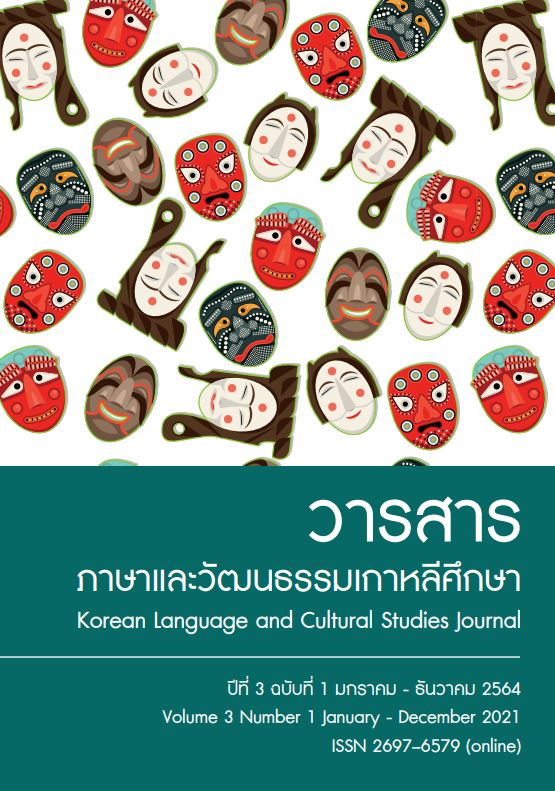A Study on the Teaching and Learning Method of Sino-Korean Word for non-Chinese-speaking Learners Focusing on Using Vocabulary Guessing Strategies
Main Article Content
Abstract
This study aims to find effective Sino-Korean word teaching and learning methods for non-Chinese-speaking Korean learners. Chinese characters are introduced in Korea and are important as they have influenced the Korean vocabulary system. However, the role of Chinese characters in current Korean language has decreased significantly, but it plays a very big role in terms of the meaning of vocabulary. In terms of Korean language education as a foreign language, Chinese and Japanese Korean learners have prior knowledge of Chinese characters, so they can easily infer the meaning of Sino-Korean word through Chinese character shapes or notes.
The fact that non-Chinese-speaking Korean learners have no background knowledge of Chinese characters compared to Chinese-speaking and Japanese-speaking Korean learners, makes learning Korean uncomfortable and more difficult. Through this study, an online survey was conducted on 12 Thai students who have middle and advanced Korean language skill to examine the current status of Sino-Korean word education, the importance of Chinese characters in learning Korean vocabulary, and the needs of learners to learn Sino-Korean word. In addition, prior studies and reading materials collected theoretical information on how Sino-Korean word education affects Korean reading education and vocabulary education. Hopefully, this study will effectively help non-Chinese Korean learners, especially Thai Korean language learners and Korean language education in Thailand.
Article Details
References
김선정, Park, Jincheol, 민경모. (2017). KFL 학습자의 읽기 능력 및 어휘력비교: 한자문화권 학습자와 비한자문화권 학습자의 비교를 중심으로. 언어와 문화, 13(1), 1-22.
김신혜, (2019). 비한자문화권 학습자의 한국어 어휘 의미 추론 전략 사용 양상 연구: 중국어 학습 경험 유무 및 한국어 숙달도 간 비교를 중심으로. 고려대학교 석사학위논문.
김지형. (2003). 한국어 교육에서의 한자 교수법: 비한자권 외국인 학습자를 중심으로. 국제어문학회, 27, 343-358.
림타우 쁘라팟. (2013). 태국인 중급 한국어 학습자를 위한 한자어 교육 연구. 경희대학교 석사학위논문.
박덕유, 이박문, 단채미. (2019). 비한자문화권 초급 학습자를 위한 한자어 교육 방안 연구: TOPIK 초급 한자어를 중심으로. 어문연구학회, 102, 203-242.
서울대학교 한국어문학연구소, 서울대학교 국어교육연구소, 서울대학교 언어교육원 공편. (2019). 한국어 교육의 이론과 실제 2. 아카넷.
설혜경, 심혜령. (2009). 비한자문화권 학습자를 위한 한자어 교육 연구. 연세대학교 언어연구교육원 한국어학당, 34, 157-174.
오은희. (2008). 한국어 학습자의 어휘추측전략 분석 연구: 한자권-비한자권 중·고급 학습자를 대상으로. 연세대학교 석사학위논문.
윤미소. (2019). 비한자권 중급 한국어 학습자를 위한 한국어 한자 접두사 교수가 어휘력에 미치는 영향. 이화여자대학교 석사학위논문.
이선웅, 이정화, 서경숙. (2019). 한국어 어휘 교육론. 한국문화사.
이영희. (2008). 외국인을 위한 한자어 교육 연구. 숙명여자대학교 박사학위논문.
________. (2019). 비한자권 학습자를 위한 모바일 기반 한자어 학습에 대한 연구. 한국리터러시학회, 2019(5), 69-77.
이응백, 김원경, 김선풍. (1998). 국어국문학자료사전. 한국사전연구사.
이익섭, 이상억, 채완. (1997). 한국의 언어. 신구문화사.
조미선. (2012). 비한자권 한국어 학습자를 위한 한자어 교육 방안 연구. 영남대학교 석사학위논문.
진우성. (2015). 영어권 한국어 학습자를 위한 교육용 한자 선정 연구: 미국인 한국어 학습자를 중심으로. 연세대학교 석사학위논문.


